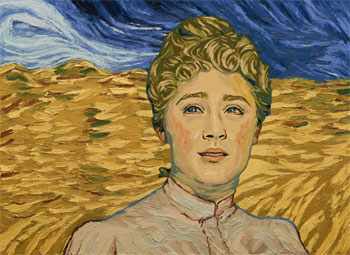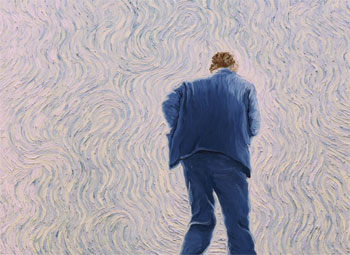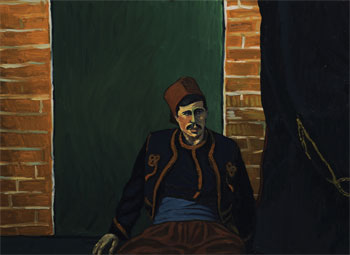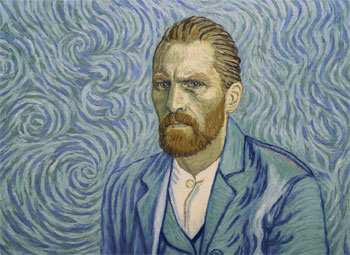Douglas Booth Loving Vincent

Douglas Booth Loving Vincent
Cast: Jerome Flynn, Saoirse Ronan, Aidan Turner
Directors: Dorota Kobiela, Hugh Welchman
Genre: Mystery, Art House, Biopic
Running Time: 94 minutes
Synopsis: France, Summer 1891. Armand Roulin (Douglas Booth), a feckless and directionless young man, is given a letter by his father, Postman Joseph Roulin (Chris O'Dowd), to hand-deliver to Paris. He is to deliver it to the brother of his father's friend Vincent van Gogh who, they have just heard, killed himself. Armand is none too pleased with the mission: he is embarrassed by his father's association with Vincent, a foreign painter who cut off his ear and was committed to the local asylum.
In Paris there is no trace of the brother. Armand's search leads him to the paint supplier, Pere Tanguy (John Sessions), who tells him that the brother died shortly after Vincent, apparently destroyed by the death of his older brother.
Pere recounts how the brother helped Vincent on this incredible transformation from a down-and-out at 28 who had failed at three careers and was living in a barn in the mining district of the Borinage in Belgium with a bunch of books and no idea what to do next, to the new artistic sensation of Paris at the time of his death 10 years later. After hearing this story Armand believes he may have misjudged his father's friend, and really wants to know why, after such struggle, Vincent chose the moment of impending success to take his life: Pere has no answer to this.
Armand journeys on to Vincent's final destination, the quiet village of Auvers-sur-Oise, an hour outside Paris, to meet Doctor Paul Gachet (Jerome Flynn), Vincent's doctor in his final weeks, to find the answer. The doctor is away for couple of days. Armand resolves to wait, during which time the villagers tell him different theories of why Vincent took his life and who is to blame.
While in Auvers-sur-Oise Armand stays at the Ravoux Inn, where Vincent stayed for the last 10 weeks of his life, and where on 29th July 1890 he died of a bullet wound to his abdomen. Here Armand meets the Inn-keeper's daughter, Adeline Ravoux (Eleanor Tomlinson). While he awaits Doctor Gachet's return, Armand also interviews Doctor Gachet's housekeeper, Louise Chevalier (Helen McCrory), the Doctor's daughter, Marguerite Gachet (Saoirse Ronan), and by the river where Vincent often spent his days he meets the Boatman (Aidan Turner).
Armand gets the sense that the truth is being hidden from him, and feels like a pawn in overlapping village feuds. Armand is determined to root out the truth, for his father, for Vincent's memory, and for himself. A run in with the local police, an unexpected encounter with a second Doctor, and finally his much-anticipated meeting with the mercurial Doctor Gachet, lead to unexpected and heart-rending revelations, but also to Armand understanding and appreciating the passionate and surprising life of Vincent van Gogh.
Loving Vincent
Release Date: November 2nd, 2017
LovingVincent.com
Trailer
 About The Production
About The Production
Loving Vincent Oil – Painting Animation technique
Despite the film being animated, all of the characters in Loving Vincent are played by actors. These actors worked either on sets specially constructed to look like Van Gogh paintings, or against green-screens, with the Van Gogh paintings being composited in, along with computer generated animation, after the shoot. The live action shoot took place at Three Mills Studios in London and CETA studio in Wroclaw. The experienced film crew included cinematographers Lukasz Zal (Oscar nominated for Ida) and Tristan Oliver (Fantastic Mr. Fox, Chicken Run). The footage from the live action shoot then becomes the reference footage for the painting-animators.
The art form of film is different from painting. Painting is one particular moment in time, frozen. Film is fluid, seeming to move through space and time. So, prior to and during the live action shoot the painting design team spent a year re-imagining Vincent's painting into the medium of film. There are 94 Vincent paintings that feature in a form very close to the original, and a further 31 paintings featured either substantially or partially.
Vincent's paintings come in different shapes and sizes, so the design painters had to work out how to best show these paintings within the frame set by the cinema screen. This required breaking outside the frames of Vincent's paintings, while still retaining the feel and inspiration of Vincent's originals. They also had to work out how to deal with -invasions', where a character painted in one style, comes into another Vincent painting with a different style. Sometimes they must also, for story purposes, change daytime paintings into night time paintings, or re-imagine paintings which were done in Autumn or Winter, for summer when the journey of the film takes place.
The Character Design Painters specialized in re-imagining our actors as their famous portraits, so that they would retain their own features and at the same time recognizably take on the look and feeling of their character in painting form. There were 377 paintings painted during the design painting process.
The painting animators then use the reference footage, and paint over this with reference to the style (brushstrokes, colours, impasto) set by the design paintings to paint the first frame of their shot on canvas, sized 67cm by 49cm. They then animate the shot by re-painting, matching the brushstrokes, colour and impasto of their previous frame, for all parts of the shot that are moving. At the end they are left with a painting of the last frame of the shot. Each frame is recorded with a Canon 6D digital stills camera at 6k resolution.
The Painting Animators work in the Painting Animation Work Stations (PAWS) designed by BreakThru Films over the course of 2 years during the development of the project. PAWS allow the painter to focus as much attention as possible on painting and animating without being concerned about lighting and technology, and allow for consistency across the photographs being taken in 97 PAWS in 3 studios in 2 countries. 12 of these highresolution photographs make up each second of the film. After the photographing of the frames of painting there is simply some flicker correction, as the light-bulbs change temperature during the animation, and some colour correction to balance between shots, and that's it. So what the audience will be seeing is [65,000] high resolution photographs of actual oil-paintings.
 Vincent Van Gogh – A Brief Introduction
Vincent Van Gogh – A Brief Introduction
'We cannot speak other than by our paintings"
Vincent was born in The Netherlands, the eldest surviving son of a Parson. His parents came from well-connected families. Vincent was named after his father's childless elder brother, Vincent -Cent' van Gogh, who had made a fortune as Holland's pre-eminent art dealer. Vincent's parents were angling for their son to take over this lucrative business when choosing his name. Indeed, Vincent joined the art-dealing firm when he was 16. Despite having shown no particular interest in or aptitude for art as a child, Vincent threw himself into learning everything he could about art. This encyclopaedic knowledge didn't stop him from being side-lined within the firm, as he was seen as unable to deal with clients, and eventually sacked. His sacking was a humiliation for his parents, and Vincent tried to redeem himself, after false starts as a teacher in England and a Bookseller's assistant in The Hague, by studying to become a parson like his father.
However, this led to further humiliation when it became clear he wasn't academically gifted enough to pass the Pastor's exams despite a year of private coaching provided by his parents. Still his father managed to secure him a position, although on the lowest rung of the ecclesiastical career ladder, as an evangelical preacher's assistant in the desperately poor mining district of the Borinage. Vincent was sacked from this lowly position for being -excessively religious'. He gave away the church's possessions, his own food and even his own clothes, to the miners.
Vincent then reached a low point, refusing help from his family, and living in a hay barn in the Borinage. His beloved younger brother, Theo van Gogh, who unlike his brother was working successfully for the art dealership, visited him to try and revive him out of his depression. Theo suggested that Vincent should capitalise on his love of art, and work to become an artist. Vincent, aged 27, grabbed at this lifeline and started teaching himself to draw from manuals provided by Theo. Although drawing didn't come naturally to him, Vincent's prodigious work ethic, often practicing all through the day and all through the nights as well, led him to steadily improve.
He was taken under the wing of his uncle by marriage, Anton Mauve, Holland's most famous living painter. However, Vincent fell out with Mauve, partly because Vincent had taken in a prostitute and her children into his studio. This scandalized his whole family, and under financial pressure from Theo, who was supporting him completely, he moved back to his parent's parsonage. As fast as Vincent's work was improving, it was here that Vincent completed his first masterpiece, -The Potato Eaters', his relations with his family were deteriorating. Vincent had declared himself completely against the church, and fought bitterly with his father. When his father died prematurely of a heart attack his sisters and mother blamed Vincent, saying the stress he heaped on his father had put him in an early grave.
After short and unsuccessful spells in Antwerp and on the moorland of Drethe Vincent turned up on Theo's doorstep in Paris. Theo's connections got Vincent into the Cormon Atelier, alongside bright young painters such as Toulouse-Lautrec and Emile Bernard. Vincent was rather shunned by the younger and, by everyone's reckoning at the time, more talented painters, until Theo was appointed by his gallery to buy impressionist art.
This made Theo the most sought after friend for painters working in the new styles, and this made Vincent sought after company as well. There followed three months where Vincent together with Theo were at the centre of a group of the most interesting new painters. However, their party life style was severely damaging Theo's health and also Vincent felt his work was stagnating. So Vincent struck out on his own for the South in search of sunshine and blossoms, as seen in the Japanese prints he was obsessed with. Very unusually when he arrived in Arles in Provence it was snowing, however it wasn't long before the snow melted and the blossoms burst forth. Also bursting out, from Vincent, was a new style of painting, the style we recognize today as Vincent's style, which synthesized his Dutch period, the new styles he had learnt in Paris and his study of Japanese prints. Alongside a prodigious output of new paintings Vincent concocted a plan to set up an artists' studio, which other artists from his Paris group could come and join, and so he rented the Yellow House. Only Gauguin, enticed by free board and rent, made the trip. A brief honeymoon period was soon eclipsed as competition and resentment grew between them, and heated arguments raged in the Yellow House, until one night after an argument, Vincent sliced off his ear and made a present of it to his favourite whore. Gauguin left Arles the next morning, and Vincent was committed to the local mental asylum. After two weeks Vincent seemed completely recovered from his fit, but after a month his health deteriorated again, and under pressure from his neighbours, who signed a petition asking the mayor to remove him, Vincent voluntarily committed himself to the private mental asylum at St Remy in the Alpilles. For one year he alternated between feeling completely normal and having periods of terrifying fits, until he considered himself well enough to leave.
 He travelled back up North, to be near Theo, but didn't want the bustle and distractions of Paris, so he moved to the sleepy resort village of Auvers-Sur-Oise, an hour outside of Paris. The village had long been a magnet for painters, following in the footsteps of Charles Daubigny, and many of the bigger houses were second homes for rich Parisians. As well as its reputation for tolerating painters, additionally Vincent was there because of Doctor Paul Gachet, a doctor who specialized in treating melancholia in artists, and who was a passionate supporter of the new painters in Paris, and Doctor to other painters such as friend to the Van Gogh's, Pissarro. Gachet was something of a painter himself, and aspired to be more that what he was, a gentleman painter.
He travelled back up North, to be near Theo, but didn't want the bustle and distractions of Paris, so he moved to the sleepy resort village of Auvers-Sur-Oise, an hour outside of Paris. The village had long been a magnet for painters, following in the footsteps of Charles Daubigny, and many of the bigger houses were second homes for rich Parisians. As well as its reputation for tolerating painters, additionally Vincent was there because of Doctor Paul Gachet, a doctor who specialized in treating melancholia in artists, and who was a passionate supporter of the new painters in Paris, and Doctor to other painters such as friend to the Van Gogh's, Pissarro. Gachet was something of a painter himself, and aspired to be more that what he was, a gentleman painter. Vincent at first seemed to fare well in Auvers-sur-Oise, and threw himself into his work and also a friendship with Doctor Gachet. However, Vincent was still worried about many aspects of his life: money, his state of health, his brother and his brother's new baby, his isolation from people. There also seems to have been a deterioration in his initially warm relations with Doctor Gachet, and only 10 weeks after arriving in Auverssur-Oise, having painted 70 paintings, Vincent arrived back at the Ravoux Inn on a Sunday night with a mortal wound to his chest. He stated that he had shot himself. He came back without the painting gear that he had left with, and without a gun on him. Neither his painting gear nor the gun was ever found. Vincent died two days later, his beloved brother Theo at his side.
Loving Vincent
Release Date: November 2nd, 2017
LovingVincent.com
Trailer
MORE
- Mission: Impossible Fallout
- Glenn Close The Wife
- Allison Chhorn Stanley's Mouth Interview
- Benicio Del Toro Sicario: Day of the Soldado
- Dame Judi Dench Tea With The Dames
- Sandra Bullock Ocean's 8
- Chris Pratt Jurassic World: Fallen Kingdom
- Claudia Sangiorgi Dalimore and Michelle Grace...
- Rachel McAdams Disobedience Interview
- Sebastián Lelio and Alessandro Nivola...
- Perri Cummings Trench Interview



